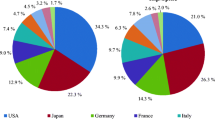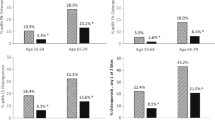Abstract
BACKGROUND: Data about whether Asian Americans are a high-risk or a low-risk group for osteoporosis are limited and inconsistent. Few previous studies have recognized that the heterogeneity of the Asian American population, with respect to both nativity (foreign- vs U.S.-born) and ethnicity, may be related to osteoporosis risk.
OBJECTIVE: To assess whether older foreign-born Chinese Americans living in an urban ethnic enclave are at high risk of osteoporosis and to refer participants at high risk for follow-up care.
DESIGN: Cross-sectional survey and osteoporosis screening, undertaken as a collaborative project by the Chinese American Service League and researchers at the University of Chicago.
SETTING: Chicago’s Chinatown.
PARTICIPANTS: Four hundred sixty-nine immigrant Chinese American men and women aged 50 and older.
MEASUREMENTS AND MAIN RESULTS: Chinese Americans in this urban setting are generally recent immigrants from south China with limited education and resources: mean age at immigration was 54, 56% had primary only or no education, and 57% reported “fair” or “poor” self-rated health. Eighteen percent are uninsured and 55% receive Medicaid. Bone mineral density (BMD) of the calcaneus was estimated using quantitative ultrasound. Immigrant Chinese women in the study had lower average BMD than reference data for white women or U.S.-born Asian Americans. BMD for immigrant Chinese men in the study was similar to white men at ages 50 to 69, and lower at older ages. Low body mass index, low educational attainment and older age at immigration were all associated with lower BMD.
CONCLUSIONS: Foreign-born Chinese Americans may be a high-risk group for osteoporosis.
Similar content being viewed by others
References
Looker AC, Wahner HW, Dunn WL, et al. Updated data on proximal femur bone mineral levels of US adults. Osteoporos Int. 1998;8:468–89.
Looker AC, Orwoll ES, Johnston CC Jr, et al. Prevalence of low femoral bone density in older U.S. adults from NHANES III. J Bone Miner Res. 1997;12:1761–8.
National Osteoporosis Foundation. American Academy of Orthopaedic Surgeons. Physician’s Guide to Prevention and Treatment of Osteoporosis. Washington, DC: National Osteoporosis Foundation; 1998.
Siris ES, Miller PD, Barrett-Connor E, et al. Identification and fracture outcomes of undiagnosed low bone mineral density in postmenopausal women: results from the National Osteoporosis Risk Assessment. JAMA. 2001;286:2815–22.
Nattress S, Orwell E, Tylavsky F, et al. Male and ethnic reference values for the Sahara Clinical Bone Sonometer. J Bone Miner Res. 1999;14(suppl):501.
Tanjasiri SP, Wallace SP, Shibata K. Picture imperfect: hidden problems among Asian Pacific islander elderly. Gerontologist. 1995;35:753–60.
Ma GX. Barriers to the use of health services by Chinese Americans. J Allied Health. 2000;29:64–70.
Ma GX. Between two worlds: the use of traditional and Western health services by Chinese immigrants. J Community Health. 1999;24:421–37.
Jang M, Lee E, Woo K. Income, language, and citizenship status: factors affecting the health care access and utilization of Chinese Americans. Health Soc Work. 1998;23:136–45.
Tabora BL, Flaskerud JH. Mental health beliefs, practices, and knowledge of Chinese American immigrant women. Issues Ment Health Nurs. 1997;18:173–89.
Pollard KM, De Vita CJ. A portrait of Asians and Pacific Islanders in the United States. Stat Bull Metrop Insur Co. 1997;78:2–9.
Saphir A. Asian Americans and cancer: discarding the myth of the “model minority.” J Natl Cancer Inst. 1997;89:1572–4.
Kuo J, Porter K. Health status of Asian Americans: United States, 1992–94. Adv Data. 1998;298:1–16.
Behavioral risk factor survey of Chinese-California, 1989. MMWR Morb Mortal Wkly Rep. 1992;41:266–70.
Wang CY, Abbott LJ. Development of a community-based diabetes and hypertension preventive program. Public Health Nurs. 1998;15:406–14.
McPhee SJ, Stewart S, Brock KC, Bird JA, Jenkins CN, Pham GQ. Factors associated with breast and cervical cancer screening practices among Vietnamese American women. Cancer Detect Prev. 1997;21:510–21.
Folstein MF, Folstein SE, McHugh PR. Mini-Mental State. A practical method for grading the cognitive state of patients for the clinician. J Psychiatr Res. 1975;12:189–98.
Ren XS, Amick B III, Zhou L, Gandek B. Translation and psychometric evaluation of a Chinese version of the SF-36 Health Survey in the United States. J Clin Epidemiol. 1998;51:1129–38.
Chang DF, Chun CA, Takeuchi DT, Shen H. SF-36 health survey: tests of data quality, scaling assumptions, and reliability in a community sample of Chinese Americans. Med Care. 2000;38:542–8.
Prins SH, Jorgensen HL, Jorgensen LV, Hassager C. The role of quantitative ultrasound in the assessment of bone: a review. Clin Physiol. 1998;18:3–17.
Frost ML, Blake GM, Fogelman I. Can the WHO criteria for diagnosing osteoporosis be applied to calcaneal quantitative ultrasound? Osteoporos Int. 2000;11:321–30.
Kung AW, Tang GW, Luk KD, Chu LW. Evaluation of a new calcaneal quantitative ultrasound system and determination of normative ultrasound values in southern Chinese women. Osteoporos Int. 1999;9:312–7.
Marquez MA, Melton LJ 3rd. Muhs JM, et al. Bone density in an immigrant population from Southeast Asia. Osteoporos Int. 2001;12:595–604.
Ross PD, He Y, Yates AJ, et al. Body size accounts for most differences in bone density between Asian and Caucasian women. The EPIC (Early Postmenopausal Interventional Cohort) Study Group. Calcif Tissue Int. 1996;59:339–43.
Bhudhikanok GS, Wang MC, Eckert K, Matkin C, Marcus R, Bachrach LK. Differences in bone mineral in young Asian and Caucasian Americans may reflect differences in bone size. J Bone Miner Res. 1996;11:1545–56.
Osteoporosis Prevention, Diagnosis, and Therapy. NIH Consensus Statement, NIH Consensus Development Conference on Osteoporosis Prevention, Diagnosis, and Theraphy, Bethesda, MD, March 27–29, 2000.
Kung AW, Yeung SS, Chu LW. The efficacy and tolerability of alendronate in postmenopausal osteoporotic Chinese women: a randomized placebo-controlled study. Calcif Tissue Int. 2000;67:286–90.
Wasnich RD, Ross PD, Thompson DE, Cizza G, Yates AJ. Skeletal benefits of two years of alendronate treatment are similar for early postmenopausal Asian and Caucasian women. Osteoporos Int. 1999;9:455–60.
Waters MC, Eschbach K. Immigration and ethnic and racial inequality in the United States. Annu Rev Sociol. 1995;21:419–46.
Author information
Authors and Affiliations
Corresponding author
Additional information
Dr. Chin did not participate in the Journal of General Internal Medicine’s editorial process for this paper.
This project was funded by the Center on Aging at the University of Chicago and the National Opinion Research Center (NORC) (NIA P30 AG-12857-06) and The Hartford Center for Geriatric Excellence, Section of Geriatrics (Department of Medicine), University of Chicago. Dr. Chin is a Robert Wood Johnson Foundation Generalist Physician Faculty Scholar.
Rights and permissions
About this article
Cite this article
Lauderdale, D.S., Kuohung, V., Chang, SL. et al. Identifying older Chinese immigrants at high risk for osteoporosis. J GEN INTERN MED 18, 508–515 (2003). https://doi.org/10.1046/j.1525-1497.2003.20331.x
Issue Date:
DOI: https://doi.org/10.1046/j.1525-1497.2003.20331.x




